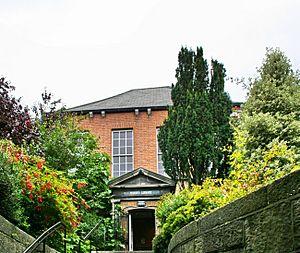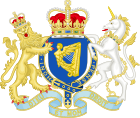Marsh's Library facts for kids
| Leabharlann an t-Ardeadaspaig Marsh | |
 |
|

Entrance
|
|
| Lua error in Module:Location_map at line 420: attempt to index field 'wikibase' (a nil value). | |
| Former name | St Sepulchre’s Library |
|---|---|
| Established | 1707 |
| Location | St Patrick's Close, Dublin, Ireland |
| Type | public library |
| Key holdings | 80 incunabula |
| Collection size | 26,000 items |
| Founder | Narcissus Marsh |
| Architect | Sir William Robinson |
| Owner | Governors and Guardians of the Library |
| Public transit access | Stephen's Green Luas stop (Green Line) Kevin Street bus stop |
Marsh's Library is a very old and special library in Dublin, Ireland. It is right next to St. Patrick's Cathedral. This library is a great example of buildings from the late Renaissance and early Enlightenment periods.
When it first opened its doors in 1707, Marsh's Library was the very first public library in Ireland. It was created by Archbishop Narcissus Marsh. Today, it holds more than 25,000 books and 300 handwritten documents called manuscripts.
Contents
History of Marsh's Library
How the Library Started
| Marsh's Library Act 1707 | |
|---|---|
| Act of Parliament | |

Parliament of Ireland
|
|
| Long title | An Act for settling and preserving a public library forever in the house for that purpose built by His Grace Narcissus, now lord archbishop of Armagh, on part of the ground belonging to the archbishop of Dublin's palace near to the city of Dublin. |
| Citation | 6 Anne c. 19 (I) |
| Introduced by | Marmaduke Coghill (Commons) |
| Territorial extent | Kingdom of Ireland |
| Dates | |
| Royal assent | 30 October 1707 |
The library was built for Narcissus Marsh, who was an Archbishop and also led Trinity College, Dublin. In 1701, the Cathedral agreed to give land for the library next to the archbishop's home. Building work began in 1703.
The first parts of the library, like the First Gallery and the Old Reading Room, were finished by 1705. The library officially became a public institution in 1707. This happened because the Irish Parliament passed a special law called the Marsh's Library Act 1707. The Second Gallery was added a little later, around 1708 or 1709.
The main design for the library was created by Sir William Robinson. A few years later, in 1710, Thomas Burgh designed an addition to the library wing and the entrance porch.
Archbishop Marsh gave his own huge collection of books to the library. This included over 10,000 books that used to belong to Bishop Edward Stillingfleet. This collection was considered one of the best in England at the time.
Dr. Elias Bouhereau, a refugee from France, became the library's first Keeper. He also donated his own personal library to Marsh's.
The library was officially set up in 1707 by the Parliament. A group called the Governors and Guardians of the Library was put in charge of the building and books. This group still looks after the library today. Narcissus Marsh passed away in 1713 and is buried near the library.
In 1745, John Stearne, who was a Bishop, gave half of his book collection to Marsh's Library.
Recent Times at the Library
In 1989, Muriel McCarthy became the first woman to be the Keeper of the library. She worked there until she retired in 2011. The person in charge now is Dr. Jason McElligott, who is called the Director.
When the Guinness family sold Farmleigh House to the Irish government, they gave the Benjamin Iveagh Library to Marsh's Library. However, these documents are still kept at Farmleigh.
You can find the library's list of books online at www.marshlibrary.ie/catalogue. Students and researchers can read the books and manuscripts if they make an appointment. Many tourists from all over the world visit this old library. In 2013, about 16,000 people visited, and by 2015, that number grew to 23,000 visitors.
What's Inside the Library
The library has more than 25,000 books from the 1500s, 1600s, and 1700s. It also has about 300 manuscripts, which are books written by hand. There are even about 80 very old books called incunabula, which were printed before the year 1501.
The books cover many different topics. You can find books on medicine, law, science, travel, navigation, math, music, and classic literature. There are also many books about religion.
Besides the 80 books from before 1501, Marsh's collection has 430 books from Italy printed before 1600. It also has 1,200 English books printed before 1640, and another 5,000 English books printed before 1700.
Marsh's collection also includes Irish manuscripts that were bought in 1695. These include works about Irish history, an Irish-Latin Dictionary from 1662, and old letters. In 1941, another collection of Irish manuscripts and deeds was given to the library.
The library also has books in many different languages, including Hebrew, Arabic, Turkish, and Russian. There is a special collection of Latin books about Jewish culture. Marsh's personal collection of Jewish texts has over 250 works, including Hebrew Bibles and writings from the Talmud. Many of these books came from the collection of Edward Stillingfleet, a Protestant clergyman. Marsh's Middle Eastern collection has many books on Near Eastern languages, Bible studies, philosophy, astronomy, and math.
The collection from Élie Bouhéreau, the first librarian, is very interesting. It focuses on France and French religious debates, as well as medicine. Many of his books were gifts from famous writers and religious leaders. His medical books were the most up-to-date for his time. His French history books included details about the Massacre of St. Bartholomew's Day and the Siege of La Rochelle.
Among the handwritten documents, there is a book called the Lives of the Irish Saints from around the year 1400. There are also musical pieces from the 1500s and other manuscripts about religion, law, and medicine.
Inside the Library Building
The library still looks much like it did when it first opened. It has its original seats and bookshelves. The bookshelves are made of strong oak wood. You might even see some bullet holes in a few of the bookcases! These are from the Easter Rising, a historical event when a factory next door was taken over.
There are three special areas with wire fences, which are called 'cages'. These were added in the 1770s to help stop books from being stolen.
Visiting Marsh's Library Today
Marsh's Library is one of the few buildings from the 1700s in Ireland that is still used for its original purpose.
Visitors can come and explore the library for a small fee. It costs €7 for adults, or €4 for students and older people. Children under 18 can enter for free! You can check their website at https://www.marshlibrary.ie/visit for the most current opening hours.
Researchers can visit for free, but they need to apply ahead of time to reserve a spot in the Reading Room.
The library often has special exhibitions and sometimes hosts conferences. They also publish books and materials, usually related to their exhibitions and the library's catalogue.
As a charity, the library accepts donations. All donations are written down in a special book that has been used since 1707.
The library is also active on social media. Every day, they share at least one image from their collections on Instagram, Facebook, and Twitter. This gives people a peek at the amazing variety of items the library holds.
More to Explore
- Bolton Library
See also
 In Spanish: Biblioteca Marsh para niños
In Spanish: Biblioteca Marsh para niños

